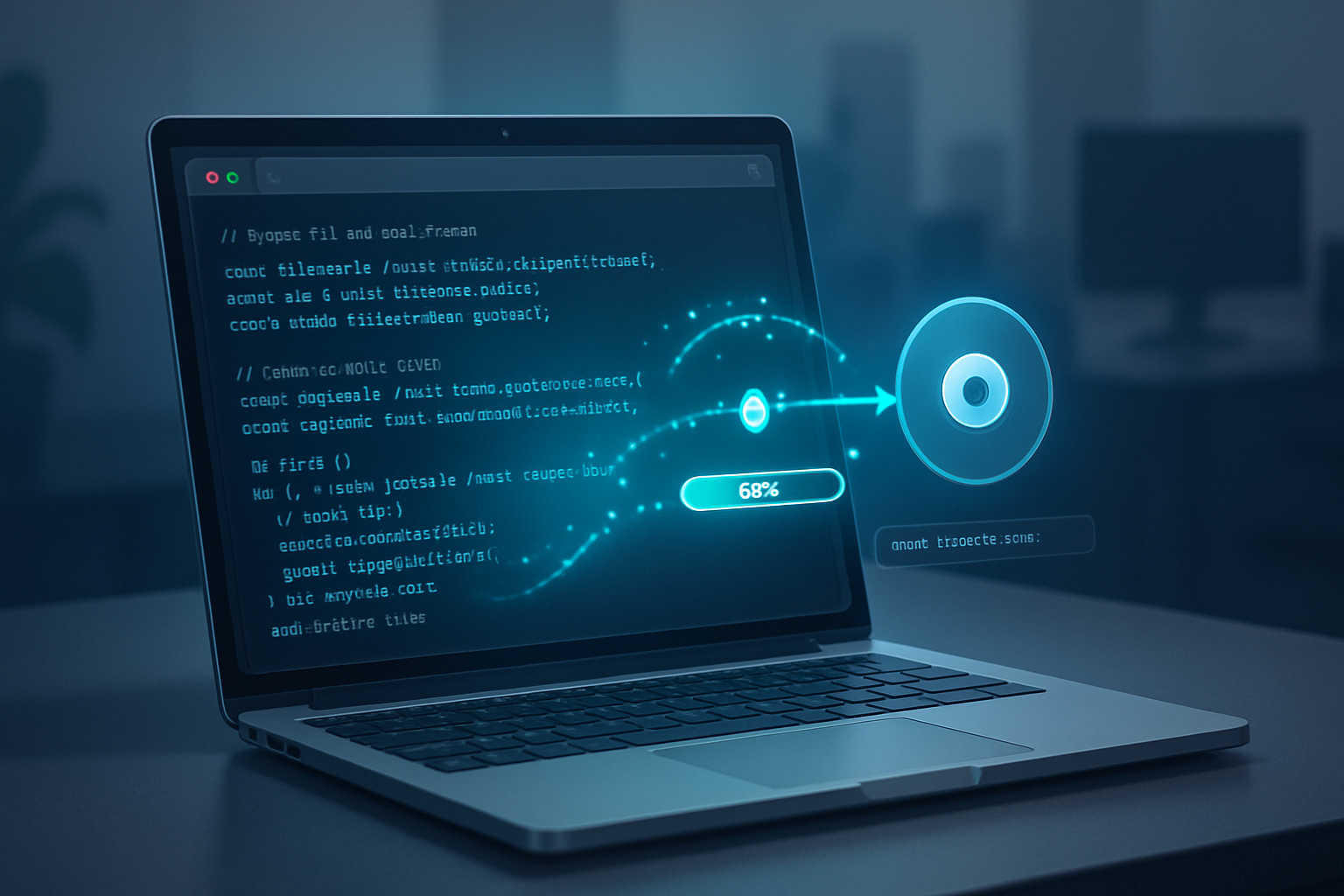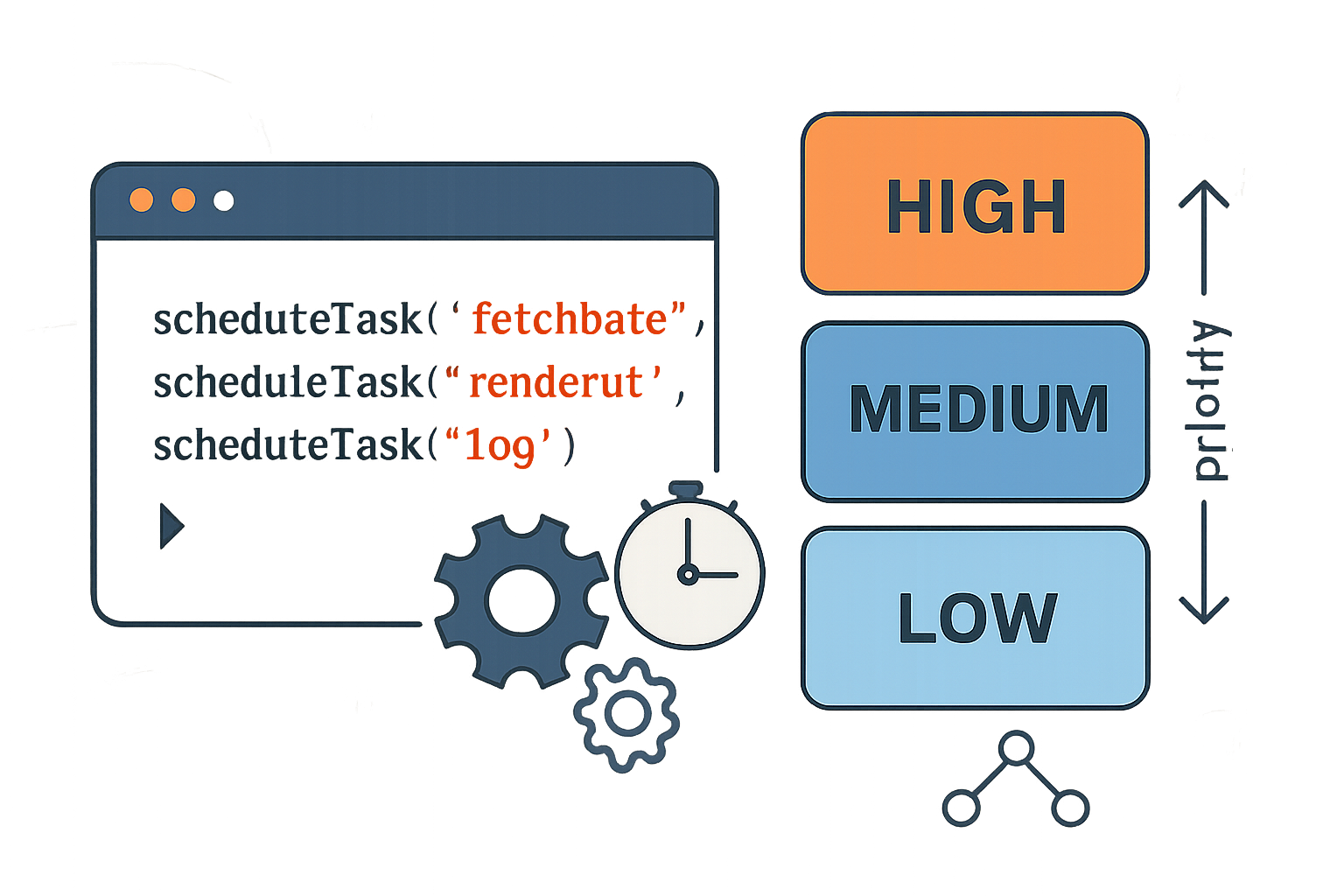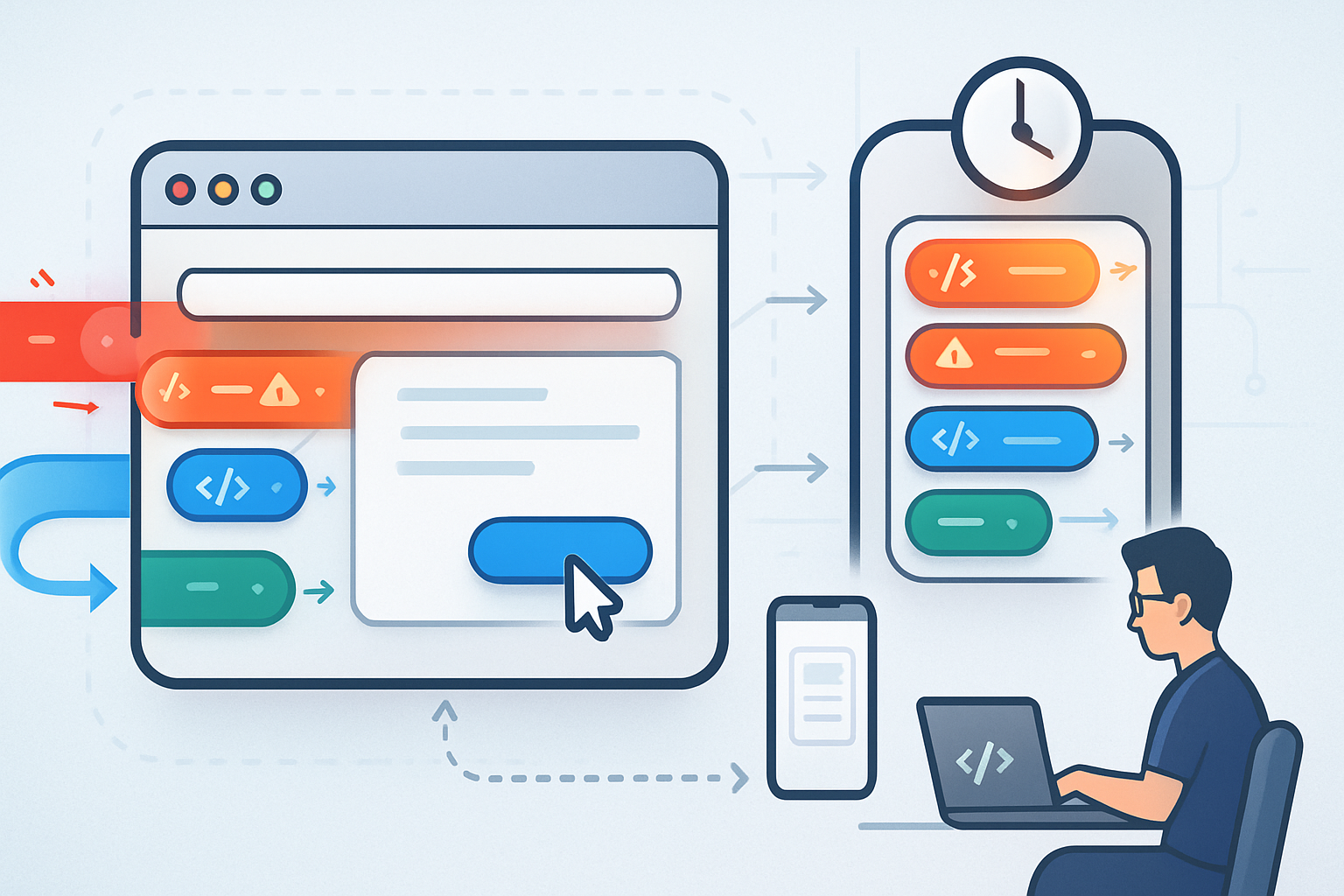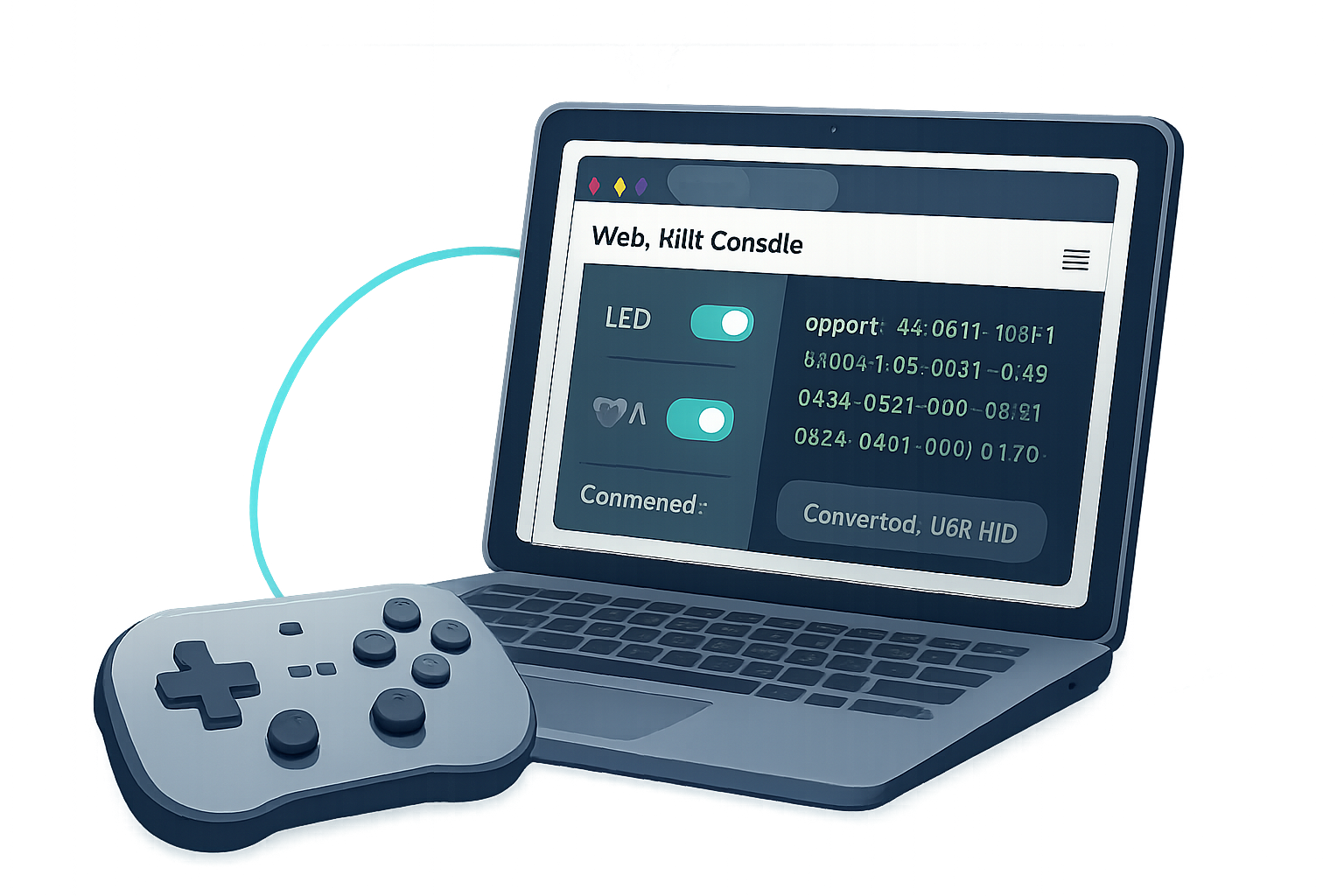· deepdives · 8 min read
Unlocking the Power of Prioritized Task Scheduling: A Deep Dive into the New API
Learn how the Prioritized Task Scheduling API (scheduler.postTask and friends) can transform performance and UX in JavaScript apps. This deep dive covers architecture, priority models, cancellation, fallbacks, hands‑on examples, and real‑world use cases.
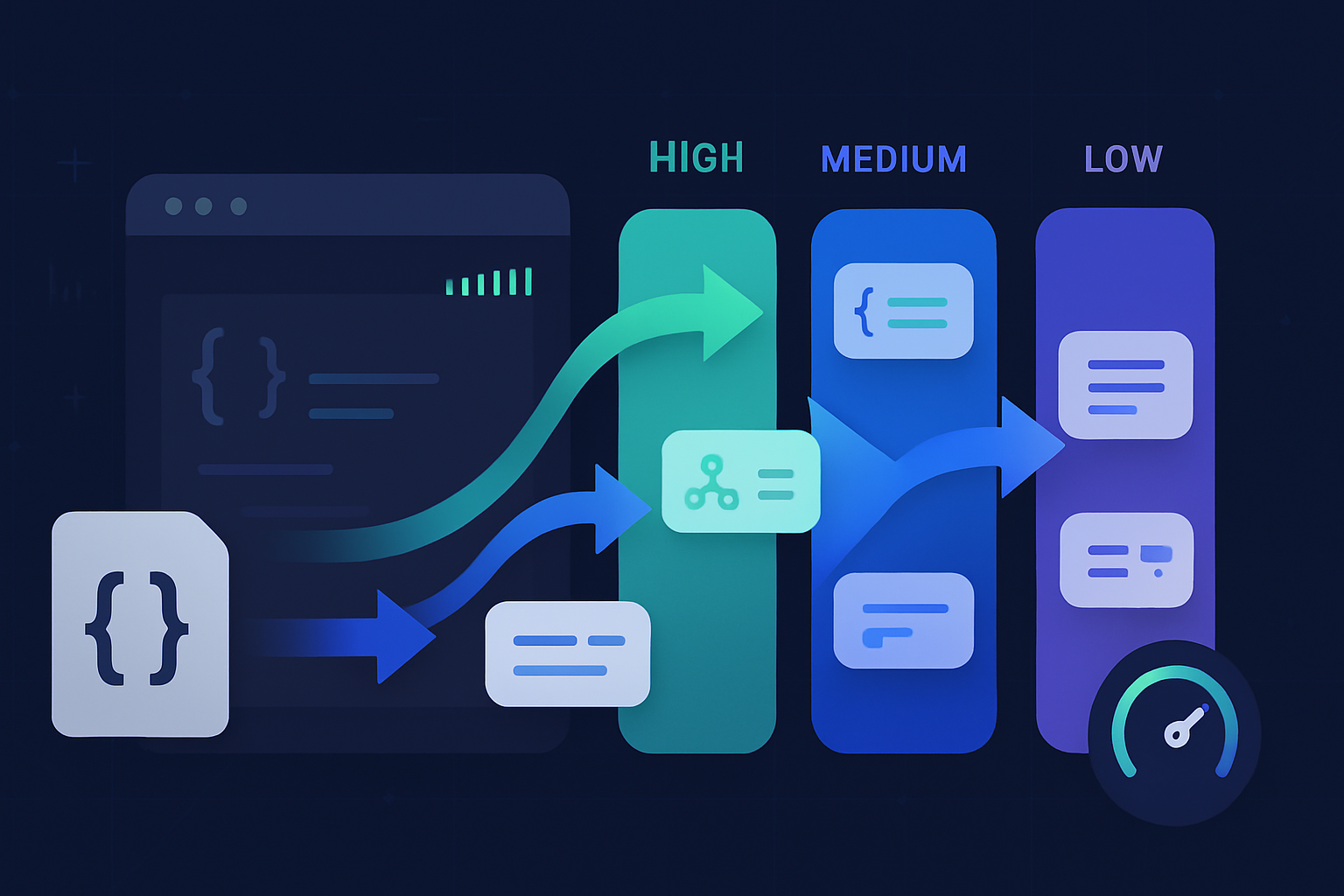
Why prioritized task scheduling matters
Modern web apps juggle many responsibilities: rendering UIs, handling user input, processing background jobs, prefetching data, logging analytics, and running occasionally expensive computations (search indexing, CRDT merges, etc.). Without explicit scheduling, everything competes for the single thread and the result is jank, delayed input response, and inconsistent user experience.
A prioritized task scheduling API gives you control over how work is queued and executed. Instead of all tasks being ‘equal’ on the event loop, you can indicate which tasks should run first and which may be deferred or throttled. That helps guarantee responsive UIs while still allowing useful background work to proceed.
This post explores the modern Prioritized Task Scheduling capabilities (commonly surfaced as scheduler.postTask in browsers that implement it), how it is designed, patterns to use, fallbacks for older browsers, and practical examples you can apply today.
The architecture and primitives (overview)
At a high level the API provides:
- A function to schedule tasks with metadata (priority, optional delay, cancellation token).
- A small set of priority classes so the runtime can order work predictably.
- Cooperative yielding and fairness strategies to avoid starvation of low-priority work.
- Integration points that respect user input responsiveness (e.g., prioritizing interactive work over background work).
Key primitives you will use in code:
- scheduler.postTask (or an equivalent task-scheduling function exposed to the global scope)
- Priority levels (examples: high / user-visible, medium / utility, low / background)
- AbortController / AbortSignal for cancellation
- Optional delay or timeout options
Note: browser vendor implementations and precise option names may vary; treat this as a conceptual map you can apply. The WICG explainer and implementations are a good reference: https://github.com/WICG/scheduler-post-task
Priority model and fairness
A good scheduler provides a small, well-defined set of priority buckets. Typical buckets you’ll see or emulate:
- user-blocking / high: tasks that must run immediately for UI or input responsiveness.
- user-visible / normal: tasks that affect the visible UI but are not urgently blocking input.
- utility / low: helpful background tasks that are nice-to-have but not urgent.
- background / idle: low-priority tasks that should yield frequently and run only when idle.
Important design goals:
- Prioritization: high-priority tasks preempt lower-priority ones when needed.
- Starvation avoidance: low-priority tasks must eventually run; the scheduler should age tasks or otherwise guarantee progress.
- Cooperative yielding: long-running tasks should yield periodically so input remains responsive.
Core patterns and best practices
- Keep tasks small and cooperative
Break big work into small chunks and yield control so the main thread can service input. Use a time-slicing pattern (run for X ms then yield).
- Use priorities to reflect user impact
Schedule immediate UI updates and input handlers as high priority; background sync, telemetry batching, prefetching as low or background.
- Cancel work that’s no longer needed
Long-lived background tasks should accept an AbortSignal so you can cancel when the user navigates away or the work becomes irrelevant.
- Progressive enhancement with fallbacks
Don’t require the new API. Provide graceful fallbacks using requestIdleCallback, MessageChannel, or setTimeout so the app remains functional on older browsers.
Hands-on examples
Below are practical examples illustrating common usage patterns and progressive fallbacks.
1) Basic scheduling (high-level)
This example shows how you would schedule a task and pass metadata such as priority and a signal for cancellation. (Call signatures differ across implementations-treat this as a conceptual pattern.)
// Schedule a task and cancel it if the user navigates away
const controller = new AbortController();
if (typeof scheduler !== 'undefined' && 'postTask' in scheduler) {
// Conceptual usage; actual option names depend on implementation
scheduler.postTask(
() => {
// perform work
},
{ priority: 'high', signal: controller.signal }
);
} else {
// fallback
const id = setTimeout(() => {
/* perform work */
}, 0);
// store id so you can clearTimeout(id) if needed
}
// To cancel:
controller.abort();Note: if you’re targeting current real-world implementations, check the exact signature in the environment you run in.
2) Chunking / time-slicing for long tasks
When performing heavy calculations (e.g., indexing, diffing large lists), break the job into slices and schedule each slice with low priority or during idle windows.
function chunkedWork(
items,
processItem,
{ sliceMs = 8, priority = 'background' } = {}
) {
let i = 0;
function doSlice(deadline) {
const start = performance.now();
while (i < items.length && performance.now() - start < sliceMs) {
processItem(items[i++]);
}
if (i < items.length) {
// Schedule the next slice at low priority
scheduleTask(() => doSlice(), { priority });
}
}
scheduleTask(() => doSlice(), { priority });
}
// scheduleTask is a small wrapper we implement for compatibility
function scheduleTask(fn, opts = {}) {
if (typeof scheduler !== 'undefined' && 'postTask' in scheduler) {
return scheduler.postTask(fn, opts);
}
if ('requestIdleCallback' in window) {
return requestIdleCallback(fn);
}
return setTimeout(fn, 0);
}This approach keeps each run short (here: 8ms), yielding frequently to input and animation frames.
3) Prioritized UI updates with cancellation
When the user rapidly interacts (typing, resizing), you may schedule work at a higher priority and cancel previous scheduled tasks.
let pendingUpdateController = null;
function scheduleUIUpdate(payload) {
if (pendingUpdateController) pendingUpdateController.abort();
pendingUpdateController = new AbortController();
scheduleTask(
async () => {
if (pendingUpdateController.signal.aborted) return; // cancelled
// expensive but important UI work (layout, measurement, etc.)
updateLayout(payload);
},
{ priority: 'high', signal: pendingUpdateController.signal }
);
}This avoids wasted work when a newer user action supersedes the previous one.
4) Background prefetcher (low-priority)
Prefetching resources should never disrupt UI responsiveness. Schedule prefetch tasks at a low priority and ensure they abort on navigation.
const prefetchController = new AbortController();
function prefetch(urls) {
urls.forEach(url => {
scheduleTask(
async () => {
if (prefetchController.signal.aborted) return;
try {
await fetch(url, { mode: 'no-cors' });
} catch (e) {
// ignore
}
},
{ priority: 'background', signal: prefetchController.signal }
);
});
}
// On navigation or unload, cancel prefetches
window.addEventListener('beforeunload', () => prefetchController.abort());Fallback strategies and polyfills
Not all browsers implement the API yet. Use progressive enhancement:
- If
scheduler.postTaskexists, use it. - Else, fall back to
requestIdleCallbackfor background/low-priority work. - For higher-priority or guaranteed soon execution, use microtask/macrotask patterns (MessageChannel, Promise.resolve().then(…), setTimeout(…, 0)).
A tiny compatibility wrapper:
function scheduleTask(fn, opts = {}) {
// Best-effort: use scheduler.postTask when available
if (typeof scheduler !== 'undefined' && 'postTask' in scheduler) {
return scheduler.postTask(fn, opts);
}
// Use requestIdleCallback for background work
if (opts.priority === 'background' && 'requestIdleCallback' in window) {
return requestIdleCallback(() => fn(), { timeout: 1000 });
}
// For high-priority jobs, run soon
if (opts.priority === 'high') {
// queue microtask
Promise.resolve().then(fn);
return;
}
// Generic fallback
return setTimeout(fn, 0);
}This wrapper keeps code simple and lets you replace the internals as browser support improves.
Real-world use cases
- Smooth interactive UIs: Prioritize input handlers and critical DOM updates while relegating analytics, logging, and telemetry to background.
- Virtualized lists & infinite scrolling: Schedule measurement and buffer population at appropriate priorities to avoid stalling scroll.
- Background sync and prefetch: Download and cache resources opportunistically without blocking the main thread.
- Progressive web app install flows: Run expensive indexing or consistency checks in the background so first paint and TTI are fast.
- Large data processing (CRDT merges, client-side search): Chunk and schedule the work so that interaction remains smooth.
Measuring impact: what to watch
Use these metrics to measure the API’s effect on your app:
- First Input Delay (FID) / Input latency: does prioritization reduce perceived delay?
- Time to Interactive (TTI): are background jobs less likely to delay interactive readiness?
- Frame rate & jank: fewer dropped frames when heavy work is deferred or chunked.
- CPU utilization: better scheduling often smooths CPU usage spikes.
Automate A/B experiments to compare user-centric metrics with and without prioritized scheduling.
Common pitfalls
- Overuse of high priority: marking too many tasks as high-priority undermines the whole system and can cause jank.
- Long synchronous work inside scheduled tasks: scheduling a single long-running function defeats the purpose-chunk it.
- Assuming immediate availability: always feature-detect and provide fallbacks.
- Poor cancellation handling: tasks that ignore AbortSignal can continue wasting CPU.
Security and resource considerations
Prioritized scheduling is an affordance-not a security boundary. Rate-limit or guard background tasks that might cause network or CPU abuse. Respect user preferences: if the user has low-power mode or data-saver enabled, prefer lower priorities or fewer background ops.
Where to learn more
- WICG scheduler-post-task explainer and repo: https://github.com/WICG/scheduler-post-task
- Chrome Developers: articles and posts about scheduler.postTask and scheduling features (search “scheduler.postTask Chrome Developers”)
- MDN on requestIdleCallback for fallback reasoning: https://developer.mozilla.org/en-US/docs/Web/API/Window/requestIdleCallback
- web.dev articles on cooperative scheduling and time-slicing: https://web.dev
Summary and recommendations
The Prioritized Task Scheduling API empowers you to explicitly express the importance of work, enabling browsers (and other runtimes) to make better scheduling decisions. Use it to:
- Keep the main thread responsive by scheduling non-essential work at lower priorities.
- Break big tasks into cooperative slices and yield frequently.
- Cancel work that becomes irrelevant with AbortController.
- Provide graceful fallbacks so older browsers still behave well.
Start small: identify a few background tasks that currently cause jank (analytics batchers, prefetchers, large indexing jobs), schedule them with lower priority, and measure. You’ll often see meaningful improvements in responsiveness and user experience with a modest amount of code.
